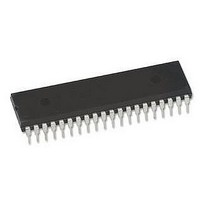P87C51FB-4N NXP Semiconductors, P87C51FB-4N Datasheet - Page 22

P87C51FB-4N
Manufacturer Part Number
P87C51FB-4N
Description
MCU 8-Bit 87C 80C51 CISC 16KB EPROM 3.3V/5V 40-Pin PDIP Tube
Manufacturer
NXP Semiconductors
Specifications of P87C51FB-4N
Program Memory Size
16 KB
Package
40PDIP
Device Core
80C51
Family Name
87C
Maximum Speed
16 MHz
Operating Supply Voltage
3.3|5 V
Data Bus Width
8 Bit
Number Of Programmable I/os
32
Interface Type
UART
Number Of Timers
3
Ram Size
256 Byte
Program Memory Type
EPROM
Operating Temperature
0 to 70 °C
Controller Family/series
(8051) 8052
No. Of I/o's
32
Ram Memory Size
265Byte
Cpu Speed
16MHz
No. Of Timers
3
No. Of Pwm
RoHS Compliant
Core Size
8bit
Oscillator Type
External Only
Lead Free Status / RoHS Status
Available stocks
Company
Part Number
Manufacturer
Quantity
Price
Company:
Part Number:
P87C51FB-4N
Manufacturer:
XILINX
Quantity:
101
1. L = Level activated
2. T = Transition activated
Philips Semiconductors
Interrupt Priority Structure
The 8XC51FA/FB/FC and 8XC51RA+/RB+/RC+/RD+ have a
7-source four-level interrupt structure (see Table 8). The 80C54/58
have a 6-source four-level interrupt structure because these devices
do not have a PCA.
There are 3 SFRs associated with the four-level interrupt. They are
the IE, IP, and IPH. (See Figures 10, 11, and 12.) The IPH (Interrupt
Priority High) register makes the four-level interrupt structure
possible. The IPH is located at SFR address B7H. The structure of
the IPH register and a description of its bits is shown in Figure 12.
The function of the IPH SFR is simple and when combined with the
IP SFR determines the priority of each interrupt. The priority of each
interrupt is determined as shown in the following table:
Table 8.
NOTES:
2000 Aug 07
80C51 8-bit microcontroller family
8K–64K/256–1K OTP/ROM/ROMless, low voltage (2.7V–5.5V),
low power, high speed (33MHz)
IPH.x
PRIORITY BITS
0
0
1
1
SOURCE
BIT
IE.7
IE.6
IE.5
IE.4
IE.3
IE.2
IE.1
IE.0
PCA
SP
X0
T0
X1
T1
T2
Interrupt Table
IE (0A8H)
IP.x
0
1
0
1
SYMBOL
EA
EC
ET2
ES
ET1
EX1
ET0
EX0
Level 0 (lowest priority)
Level 1
Level 2
Level 3 (highest priority)
INTERRUPT PRIORITY LEVEL
INTERRUPT PRIORITY LEVEL
POLLING PRIORITY
Enable Bit = 1 enables the interrupt.
Enable Bit = 0 disables it.
FUNCTION
Global disable bit. If EA = 0, all interrupts are disabled. If EA = 1, each interrupt can be individually
enabled or disabled by setting or clearing its enable bit.
PCA interrupt enable bit for FX and RX+ only – otherwise it is not implemented.
Timer 2 interrupt enable bit.
Serial Port interrupt enable bit.
Timer 1 interrupt enable bit.
External interrupt 1 enable bit.
Timer 0 interrupt enable bit.
External interrupt 0 enable bit.
EA
7
1
2
3
4
5
6
7
EC
6
ET2
5
Figure 10. IE Registers
REQUEST BITS
ES
4
TF2, EXF2
CF, CCFn
n = 0–4
RI, TI
TF0
TF1
IE0
IE1
22
ET1
as on the 80C51. An interrupt will be serviced as long as an interrupt
3
The priority scheme for servicing the interrupts is the same as that
for the 80C51, except there are four interrupt levels rather than two
of equal or higher priority is not already being serviced. If an
interrupt of equal or higher level priority is being serviced, the new
interrupt will wait until it is finished before being serviced. If a lower
priority level interrupt is being serviced, it will be stopped and the
new interrupt serviced. When the new interrupt is finished, the lower
priority level interrupt that was stopped will be completed.
EX1
2
HARDWARE CLEAR?
8XC51RA+/RB+/RC+/RD+/80C51RA+
N (L)
ET0
N (L) Y (T)
1
1
Y
Y
N
N
N
Y (T)
EX0
0
2
8XC51FA/FB/FC/80C51FA
VECTOR ADDRESS
Product specification
SU00840
03H
0B
1B
2B
13
33
23
8XC54/58
















